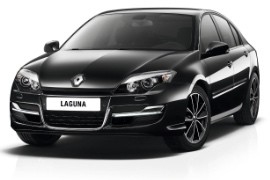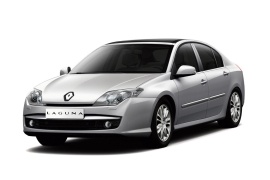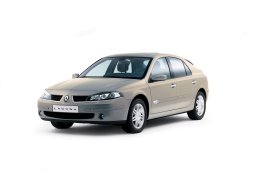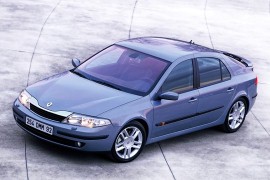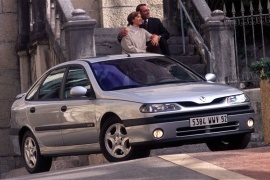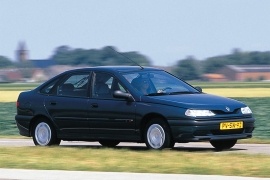RENAULT Laguna Models/Series Timeline, Specifications & Photos
First production year: 1994
Engines: Diesel, Gasoline
Body style: Hatchback
Renault introduced the third generation of the Laguna in the summer of 2007 and added a mid-life cycle refresh after just three years, in 2010.
With the world financial crisis almost gone, the French carmaker risked and introduced a facelifted version in 2010. It was a bold move, but it could do it since the French Government supported the carmaker. Its risk totally worth it since the sales started to rise again.
At the front, the carmaker changed the bumper and gave the car an aggressive look, with a lower grille which looked like it was an extension for the upper grille, below the hood. Its headlights received a new treatment. But Renault didn't want to make the Laguna a sedan. It kept the hatchback style with a sloped liftgate. At the back, the carmaker enhanced the taillights with a smoked area. Still, the wide and tall metallic part of the tailgate was criticized.
Inside, the carmaker improved the materials and the available options. Its dashboard received a new design with an integrated screen for the navigation system. The carmaker still insisted on keeping a separate stack for the audio controls behind the steering wheel, while it kept the buttons for the cruise control on the wheel, with a separate button on the center console to activate it.
Under the hood, the carmaker adjusted its engine offer and dropped the 1.6-liter naturally aspirated gasoline engine. If the 2007 model was offered with a choice of nine engines, the 2010 model came with only six of them, covering most of the customers' demands.
Renault introduced the third generation of the Laguna in 2007 and made it available as a liftback or a station wagon, adding more safety and comfort for its customers than its predecessors.
The French automaker created the Laguna as an alternative to regular sedans. Even though its main competitors, such as Opel/Vauxhall Vectra and Ford Mondeo, proposed similar body shapes, Renault managed to offer a better package in terms of engine choice, safety, and price.
The design was modern, with angled headlights and Xenon offered as an option. The tire pressure monitor and the interior design were also good points gained by Renault in front of European customers. At the back, the angular-looking taillights spread from the rear quarter panels to the trunk lid were mounted high so they were protected from parking bumps.
Inside, the new and improved entertainment system sported standard Bluetooth connectivity, which added more points to the final safety score offered by the EuroNCAP organization. At the front, the automaker installed a pair of bucket seats that offered minimal bolstering, and cloth upholstery, while at the back, the split-folding bench was suitable for two adults. On the upper trim levels, the carmaker also offered a leather-wrapped interior.
There was a 2.0-liter gasoline engine, naturally aspirated or turbo, with three power levels: 140 hp, 170 hp, and 205, respectively. When the car was launched, the diesel market in Europe was in full expansion. This is why the Laguna was offered with four turbo-diesel variants ranging from a frugal 1.5-liter dci with 110 hp to a powerful 2.0-liter dci with 175 hp. The transmissions offered were either with a six-speed manual or a six-speed automatic for engines with over 150 hp.
The second generation of the Renault Laguna was launched in 2000 and, in 2005, it received a facelift that improved both the look and the technical part of the car.
The mid-size sedan/hatchback was the first car ever to receive the 5-star ranking in the European crash-tests performed by EuroNCAP. After 2001, when the test was performed, there were some modifications to the testing methods and some cars lost half or a complete start. But not Renault. The 2005 Laguna proved to be as safe as before, keeping its 5-star rating.
From the outside, there were few modifications. The keyless access was a common feature for the car. A new wheel design was introduced for specific trim levels and improvements on the interior materials were made. The front grille and the headlights were redesigned. In the rear, the twin-blade design for the taillights was replaced with a more conventional look, with turn-signal lights on the outside under a round, clear lens.
Under the hood, the car received new, Euro IV engines, and some of the older versions were phased out. A new, 2.0-liter dCi was installed with power up to 175 hp. The gasoline units were refreshed too, in order to comply with the new pollution norms. For the entire diesel range, there was a diesel particulate filter installed. Apart from the base engine models, all the others were available with a six-speed manual or automatic transmission.
After seven years on the market, the Laguna was replaced with the second generation in December 2000. It evolved into a larger car, with more comfort and more on-board technology.
The second generation of the Renault Laguna shared its platform with the Nissan Primera. It featured a longer wheelbase which led to a roomier interior. One of the most important improvements was the keyless access system, which allowed the driver to use a card to open the vehicle and start it after it inserted the key-card into a designated slot.
From the outside, the sharper look of the vehicle was a big evolution when compared to the older, rounder, Laguna. Like its predecessor, the second generation of the Laguna was offered only in two body-styles: two-and-a-half hatchback and station-wagon.
Inside, the gizmo territory started to fade away. Apart from the push-button start and the card to access the vehicle, there were not too many out-of-the-box features. The interior room was ok for its size, especially the headroom for the rear passengers. The folding seatback of the rear bench made the car more spacious if some would need the car to be used for a salesperson.
The 2000 Laguna was equipped with diesel and gasoline engines, mated as standard with a 5-speed gearbox. There was an option for a 5-speed automatic gearbox, but only for the top, V6-engine, option. The Laguna II was the first car to receive a 5-Star rating at the EuroNCAP crash tests.
Four years after the introduction of the Laguna's first generation, Renault came up with a facelift that fixed some of the areas that were criticized by customers.
Thus, in 1998, the refreshed version of the Laguna I showed not only an improved design for the front fascia but also some technical changes. Even though Renault knew that the improved version will stay on the market only for a couple of years, it had to do that to keep the mid-size hatchback in customers' focus.
Since the 1994 version was criticized for poor headlights, the new model featured clear-lens headlamps and darkened background. Still, the front fascia kept the same bird-beak design for the grille, with a lowered center area for the hood bent towards the bumper. A new set of round foglights replaced the previously used squared ones with rounded exterior shapes. Yet, the door handles and mirrors were still black.
Inside, the carmaker improved the onboard amenities. Most versions now came with an AC unit, dual airbags, and power windows for the front passengers. Last but not least, a CD player was also on the options list.
But the most important upgrades were under the hood, where the carmaker introduced new or redesigned engines. The carmaker installed a new, 1.6-liter unit on the base model, keeping a low starting price for the Laguna. Another important improvement was for the turbo-diesel lineup, which received two direct-injected powerplants that provided 100 hp and 110 hp, respectively. For those who asked for a more powerful version, the carmaker kept the 3.0-liter V6 but improved its power by almost 20 hp.
At the beginning of the '90s, Renault started to upgrade its lineup and to change the names of its vehicles, from numbers to names. The 1994 Laguna was a good example. A car that came to replace the aged Renault 21.
Patrick LeQuement, the chief-designer from Renault, started to shape the car in the late '80s. The new, curved-style era started to catch-up with the European design themes, and models such as Ford Mondeo and Opel Vectra were shaped accordingly. The car shape was ready by the beginning of 1990, but the project was postponed for another year when the road-tests were started.
In 1993 the final product was launched in November, after the Frankfurt Motor Show. The 2 ½ box design was usual for the Renault brand, who used that type for the Renault 20, 25, and Safrane, which was launched in 1992. The new headlights were longer and curved, unlike the square type from the previous models. Also, the taillights had rounded edges.
The interior featured five seats with rear folding bench, to extend the trunk space. The driver had a modern dashboard and an airbag. Later models had dual front airbags.
For the engines, the Laguna offered various options, both gasoline and diesel units. The most powerful version was a 3.0-liter V6 bi-turbo with 267 hp.
